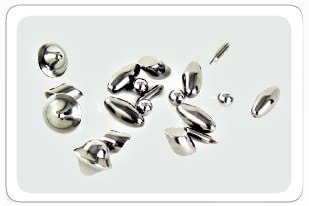Choosing the appropriate burnishing media is essential for achieving desired surface finish, shine, and texture during the burnishing process. Burnishing is a mass finishing technique used to improve the surface properties of parts through mechanical action. The right selection of burnishing media depends on factors such as the material of the parts, desired finish, and the type of equipment used. Here are some common types of burnishing media and their applications:
- Steel Media: Steel media, including steel balls and pins, is commonly used for burnishing processes. It’s versatile and effective for various materials, providing a range of finishes from smooth to textured. It’s suitable for general-purpose burnishing applications.
- Stainless Steel Media: Stainless steel media is used when corrosion resistance is required. It’s ideal for burnishing stainless steel parts and other materials that should remain free from contamination.
- Ceramic Media: Ceramic media comes in different shapes and sizes, offering options for various surface finishes. Ceramic media is often used for precision parts and delicate components that require a smooth finish without excessive material removal.
- Plastic Media: Plastic media, such as polyamide or polyester, is used for gentle burnishing. It’s suitable for delicate parts and softer materials, providing a smoother finish while minimizing the risk of part damage.
- Porcelain Media: Porcelain media is used for fine finishing and polishing. It’s suitable for achieving a high-gloss surface on a variety of materials.
- Dense Media: Dense media, like steel balls or stainless steel pins, provide more aggressive burnishing action. They are effective for removing burrs, improving part surfaces, and achieving a desired texture.
- Porcupine Media: Porcupine media is a type of plastic media with protruding points. It’s used for intricate parts and complex geometries, ensuring thorough coverage and uniform finish.
- Dry Media: Dry media, such as corn cob or walnut shells, is used for dry burnishing processes. It’s suitable for deburring and polishing while also absorbing excess moisture.
When selecting burnishing media, consider the following factors:
- Material Compatibility: Choose media that won’t react with or contaminate the parts being burnished.
- Desired Finish: Determine the level of surface finish, shine, and texture you want to achieve.
- Part Size and Shape: Select media that can access all areas of the parts, especially intricate geometries.
- Equipment Compatibility: Ensure that the media size and shape are compatible with the burnishing equipment.
- Process Time: Different media types and sizes will affect the burnishing process time.
- Cost Considerations: Balance the performance of the media with the cost of acquisition and maintenance.
Burnishing Media by STR Industries
It’s advisable to consult with STR Industries your burnishing media supplier and let our experts in mass finishing to help you choose the most suitable media for your specific burnishing requirements. Contact us today to get started.

